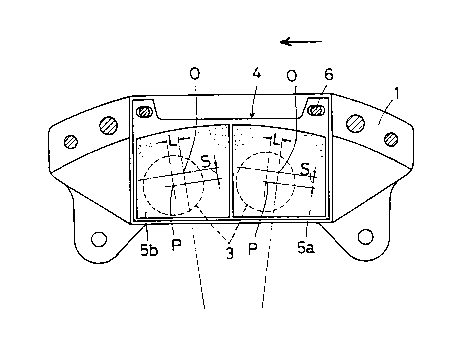Une partie des informations de ce site Web a été fournie par des sources externes. Le gouvernement du Canada n'assume aucune responsabilité concernant la précision, l'actualité ou la fiabilité des informations fournies par les sources externes. Les utilisateurs qui désirent employer cette information devraient consulter directement la source des informations. Le contenu fourni par les sources externes n'est pas assujetti aux exigences sur les langues officielles, la protection des renseignements personnels et l'accessibilité.
L'apparition de différences dans le texte et l'image des Revendications et de l'Abrégé dépend du moment auquel le document est publié. Les textes des Revendications et de l'Abrégé sont affichés :
| (12) Brevet: | (11) CA 2087148 |
|---|---|
| (54) Titre français: | FREIN A DISQUE |
| (54) Titre anglais: | DISK BRAKE |
| Statut: | Périmé et au-delà du délai pour l’annulation |
| (51) Classification internationale des brevets (CIB): |
|
|---|---|
| (72) Inventeurs : |
|
| (73) Titulaires : |
|
| (71) Demandeurs : | |
| (74) Agent: | SMART & BIGGAR LP |
| (74) Co-agent: | |
| (45) Délivré: | 1996-07-02 |
| (22) Date de dépôt: | 1993-01-12 |
| (41) Mise à la disponibilité du public: | 1993-07-14 |
| Requête d'examen: | 1993-05-10 |
| Licence disponible: | S.O. |
| Cédé au domaine public: | S.O. |
| (25) Langue des documents déposés: | Anglais |
| Traité de coopération en matière de brevets (PCT): | Non |
|---|
| (30) Données de priorité de la demande: | ||||||
|---|---|---|---|---|---|---|
|
A disk brake has a brake piston for biasing pads
against a disk. The piston is arranged so that the center
of its biasing force is offset toward the disk leading side
from the center of frictional surface of the pad. Also,
the piston is arranged so that the center of biasing force
is offset toward the center of the disk from the line
extending in the tangential direction of the disk and
passing the center of frictional surface of the pad. In
another arrangement, a disk brake has a plurality of brake
pistons adapted to bias each pad. One of the brake pistons
located at the disk leading side has a greater pressure
bearing area than that of the other brake piston at the
disk trailing side. The brake pistons are arranged so that
the center of biasing force is offset toward the center of
the disk from the line extending in the tangential
direction of the disk and passing the center of frictional
surface of the pad.
Note : Les revendications sont présentées dans la langue officielle dans laquelle elles ont été soumises.
Note : Les descriptions sont présentées dans la langue officielle dans laquelle elles ont été soumises.

2024-08-01 : Dans le cadre de la transition vers les Brevets de nouvelle génération (BNG), la base de données sur les brevets canadiens (BDBC) contient désormais un Historique d'événement plus détaillé, qui reproduit le Journal des événements de notre nouvelle solution interne.
Veuillez noter que les événements débutant par « Inactive : » se réfèrent à des événements qui ne sont plus utilisés dans notre nouvelle solution interne.
Pour une meilleure compréhension de l'état de la demande ou brevet qui figure sur cette page, la rubrique Mise en garde , et les descriptions de Brevet , Historique d'événement , Taxes périodiques et Historique des paiements devraient être consultées.
| Description | Date |
|---|---|
| Inactive : CIB désactivée | 2012-01-07 |
| Inactive : Symbole CIB 1re pos de SCB | 2012-01-01 |
| Inactive : CIB du SCB | 2012-01-01 |
| Inactive : CIB expirée | 2012-01-01 |
| Le délai pour l'annulation est expiré | 2009-01-12 |
| Lettre envoyée | 2008-01-14 |
| Inactive : CIB de MCD | 2006-03-11 |
| Inactive : CIB de MCD | 2006-03-11 |
| Accordé par délivrance | 1996-07-02 |
| Demande publiée (accessible au public) | 1993-07-14 |
| Toutes les exigences pour l'examen - jugée conforme | 1993-05-10 |
| Exigences pour une requête d'examen - jugée conforme | 1993-05-10 |
Il n'y a pas d'historique d'abandonnement
Le dernier paiement a été reçu le
Avis : Si le paiement en totalité n'a pas été reçu au plus tard à la date indiquée, une taxe supplémentaire peut être imposée, soit une des taxes suivantes :
Veuillez vous référer à la page web des taxes sur les brevets de l'OPIC pour voir tous les montants actuels des taxes.
| Type de taxes | Anniversaire | Échéance | Date payée |
|---|---|---|---|
| TM (brevet, 5e anniv.) - générale | 1998-01-20 | 1997-12-17 | |
| TM (brevet, 6e anniv.) - générale | 1999-01-12 | 1998-12-16 | |
| TM (brevet, 7e anniv.) - générale | 2000-01-12 | 1999-12-09 | |
| TM (brevet, 8e anniv.) - générale | 2001-01-12 | 2000-12-20 | |
| TM (brevet, 9e anniv.) - générale | 2002-01-14 | 2001-12-19 | |
| TM (brevet, 10e anniv.) - générale | 2003-01-13 | 2002-12-18 | |
| TM (brevet, 11e anniv.) - générale | 2004-01-12 | 2003-12-17 | |
| TM (brevet, 12e anniv.) - générale | 2005-01-12 | 2004-12-07 | |
| TM (brevet, 13e anniv.) - générale | 2006-01-12 | 2005-12-07 | |
| TM (brevet, 14e anniv.) - générale | 2007-01-12 | 2006-12-08 | |
| TM (demande, 2e anniv.) - générale | 02 | 1995-01-12 |
Les titulaires actuels et antérieures au dossier sont affichés en ordre alphabétique.
| Titulaires actuels au dossier |
|---|
| SUMITOMO ELECTRIC INDUSTRIES, LTD. |
| Titulaires antérieures au dossier |
|---|
| SATORU ITSUAKI |